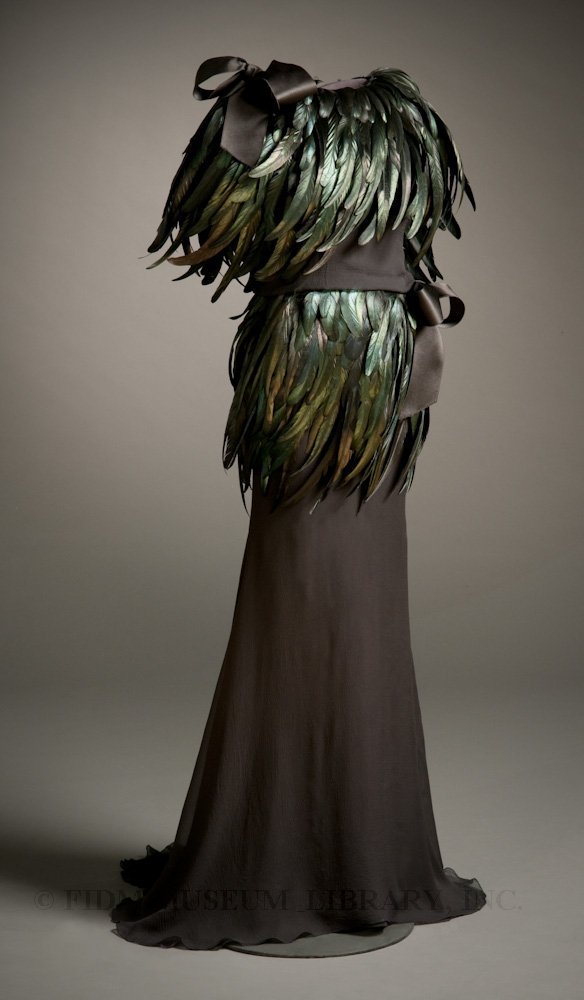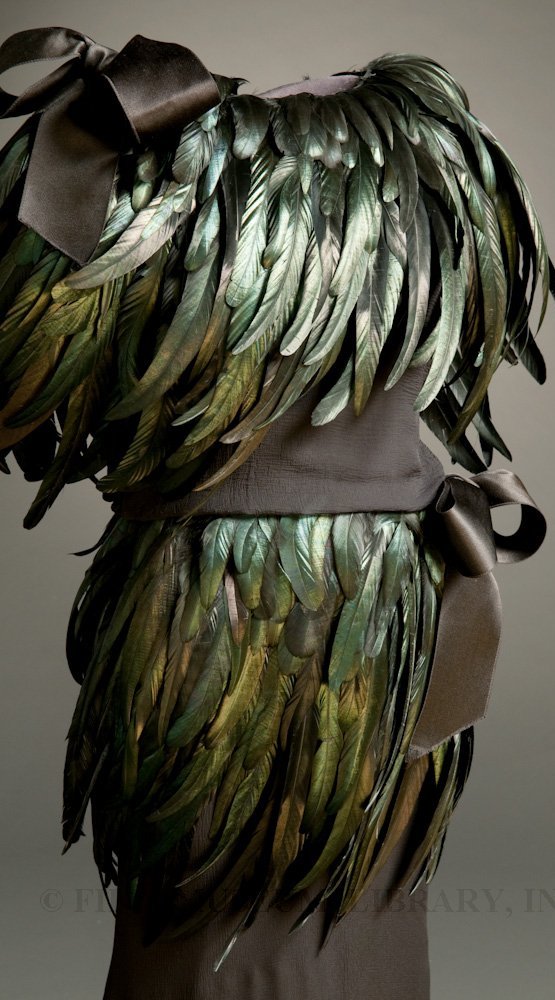Chanel evening ensemble, 1985
Designed by Karl Lagerfeld for Chanel, this dramatic evening ensemble includes a floor-length silk crepe evening gown and feathered cape. Covered with iridescent coque (rooster) feathers, the cape is a true show-stopper. Because of the inherent fragility of feathers, a garment such as this cape can only be worn a few times before the feathers begin to deteriorate. Fragile and easily abraded or broken, coque feathers are a truly opulent decorative embellishment.

Evening Ensemble
Karl Lagerfeld for Chanel
1985
Silk chiffon crepe, coque feathers
Gift of Mrs. Alfred Bloomingdale
2009.116.1AB
Sumptuous, handcrafted embellishment is an integral part of the haute couture aesthetic. Couturiers design garments, but decorative embroidery, beading, and featherwork are usually completed by specialty ateliers. Though there were once many Paris ateliers dedicated to creating handcrafted trims for the haute couture, changing aesthetics have reduced the need for embroiderers, feather-workers, and silk flower-makers. Karl Lagerfeld, who has worked in the Paris fashion industry since the mid-1950s, compared the successive closure of embroidery workshops to a classic fairy tale: "They were in Sleeping Beauty mode."1
In an effort to stem the loss of these unique crafts, in 1997 Chanel established Paraffection, a subsidiary dedicated to preserving the ateliers that collaborate with haute couture and high end ready-to-wear designers. In 2002, Paraffection acquired five historic companies: Desrues (jewelry) Lemarié (feathers and flowers), Lesage (embroiderer), Massaro (shoemaker), and Michel (milliner). Since this initial acquisition, Chanel has acquired at least 6 more workshops; the most recent purchase is the Bodin-Joyeux tannery, which was established in 1860. Though these companies are owned by Chanel, they work with anyone who wants to pay for their services, from couturiers to costume designers. According to Lagerfeld, "We [Chanel] don't even insist on coming first."2 Each year, Chanel stages the Métiers d’Art fashion presentation to showcase the handcrafted products of theses specialty ateliers.
Featherwork is the province of Lemarié. Founded in 1880, it is one of the last remaining plumassiers in France. According to the company's website, there were more than 300 Parisian plumassiers in 1900 and only 50 by 1960. In addition to featherwork, Lemarié also designs and creates artificial flowers. The atelier has a long association with Chanel; in the 1950s, Coco Chanel began purchasing silk camellia boutonnieres from Lemarié. Lagerfeld, known for his ability to reconceive Chanel's iconic symbols, uses tweed, leather, and silk Lemarié flowers in his collections. Take a look inside the atelier in this short film featuring, Eric-Charles Donatien, the current Artistic Director of Lemarié.
1 Bowles, Hamish "Alliance Francaise" Vogue (Apr 1, 2004) 194-5.
2 Ibid.
